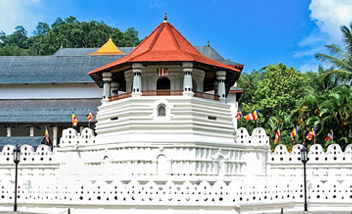 Classified as one of the greatest civilization of its kind, Anuradhapura, founded around 5th century BC, was Sri Lankaís first ancient
kingdom and capital. Now a UNESCO World Heritage site, it is the islandís most important ancient city, dotted with ancient monuments,
sacred stupas, ruins of temples and palaces, and a network of stunning irrigation lakes and reservoirs.
Classified as one of the greatest civilization of its kind, Anuradhapura, founded around 5th century BC, was Sri Lankaís first ancient
kingdom and capital. Now a UNESCO World Heritage site, it is the islandís most important ancient city, dotted with ancient monuments,
sacred stupas, ruins of temples and palaces, and a network of stunning irrigation lakes and reservoirs.
It is also home to the oldest historically authenticated tree in the world Ė Sri Maha Bodhi which resulted from a branch from the
sacred fig tree under which Lord Buddha is said to have attained enlightenment in Nothern India. This tree is currently over 2200
years old. It was brought to Sri Lanka in the 3rd century BC by the daughter of Emperor Asoka, Sanghamitta. Until the capitalís
abandonment in 993 after a South Indian invasion, the city flourished for 1,300 years.
Anuradhapura is home to some of the tallest historical monuments in the world, such as Abhayagiri, Jetavana and Ruwanweli. The oldest
stupa on the island, Thuparama is enshrined with the collar bone relic of Buddha. The network of highly sophisticated gigantic
irrigation lakes still supplies water to paddy cultivations across the province. Tissa Wewa, Abhaya Wewa and Nuwara Wewa constructed
by ancient engineers display clever hydraulic feats of this era. Monolithic sculptures of the area such as Avukana, Isurumuniya rock
temple, Kuttam Pokuna and stone pillars of Brazan Palace, which was once home to 1000 Buddhist monks are places well worth the visit.
Mihintale, often cited as the cradle of Buddhism was where Buddhism was first established in Sri Lanka with royal patronage. This is
where Emperor Asokaís son Mahinda, first preached Buddhism to then King Devanampiyatissa, the event which saw Sri Lanka embracing
Buddhism as the state religion. Featuring ancient hospitals, ponds, and temples, it is another significant place that belongs to the
antiquity of Anuradhapura.


.jpg)